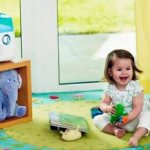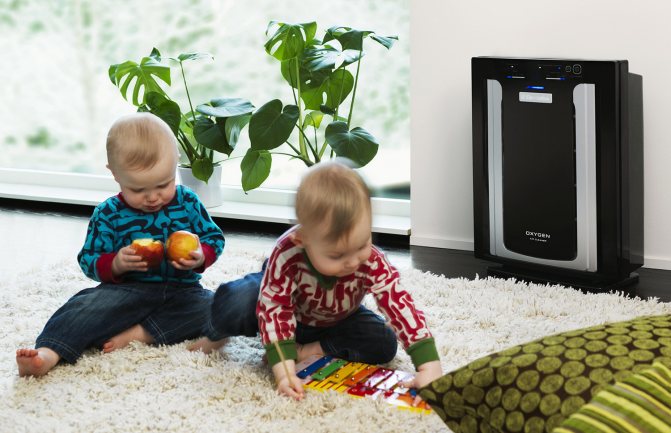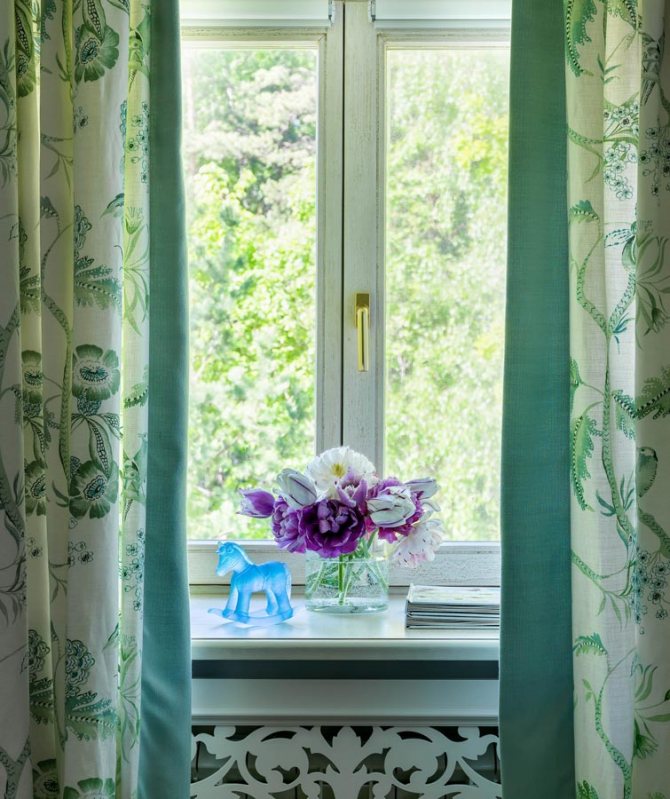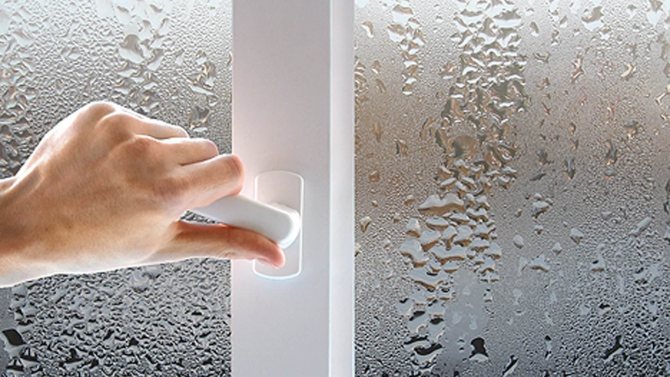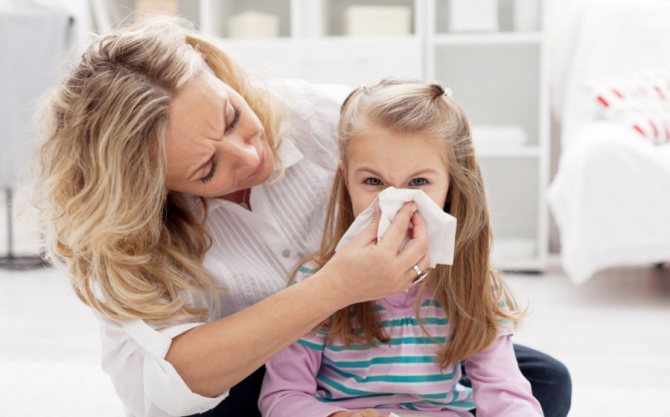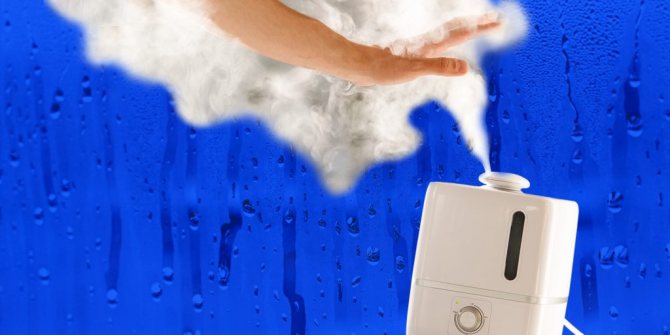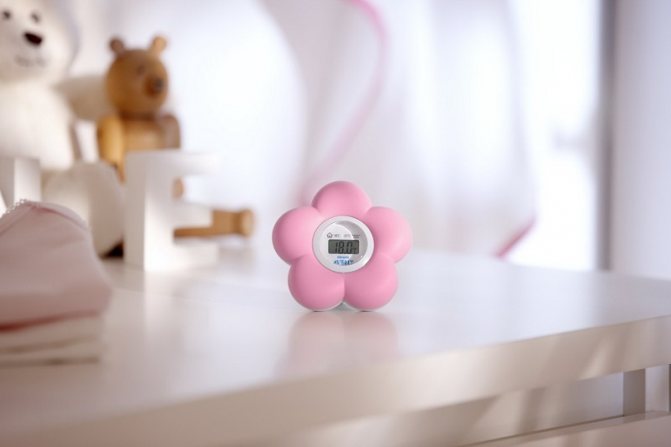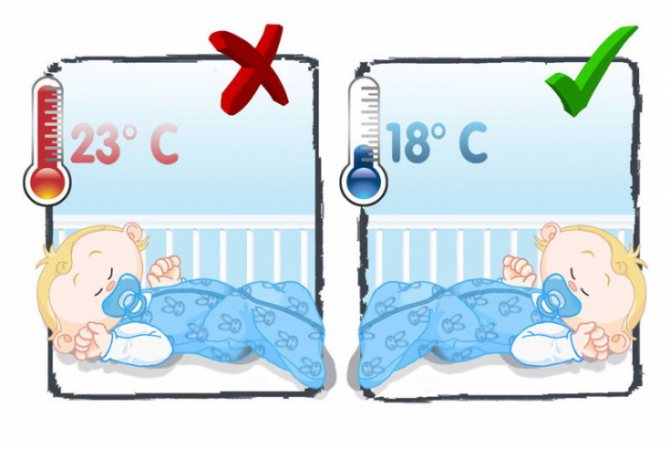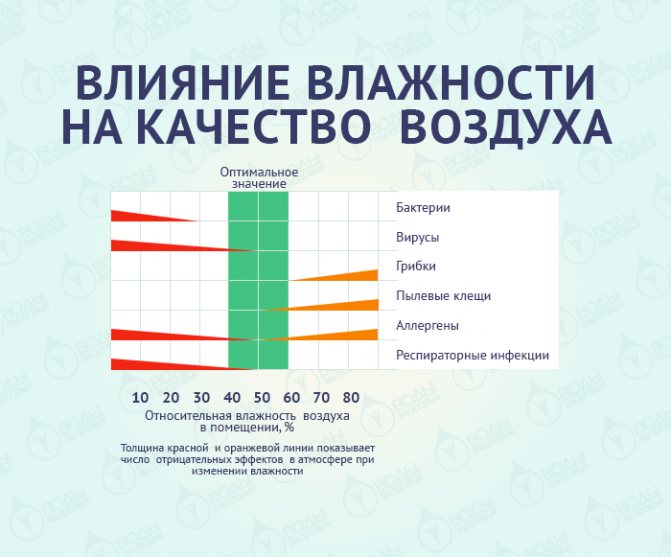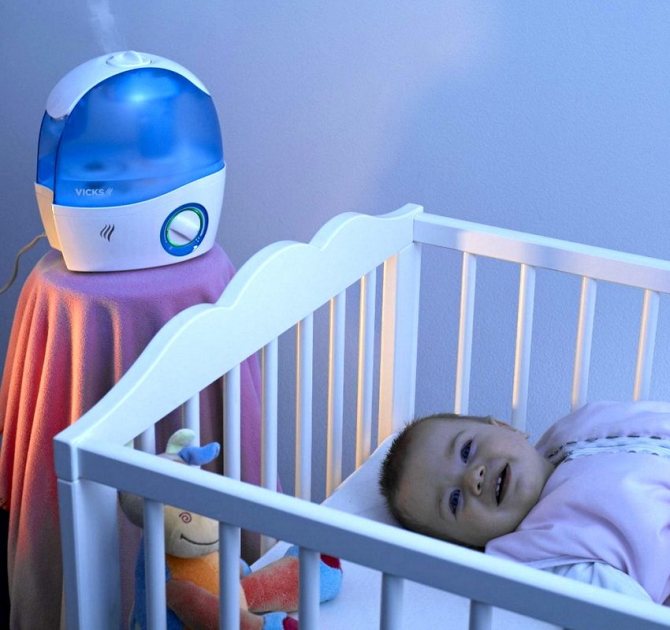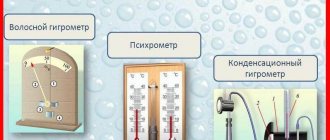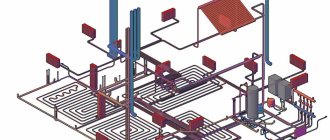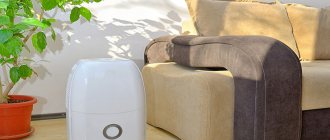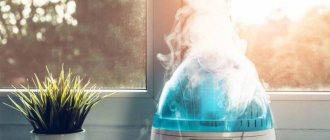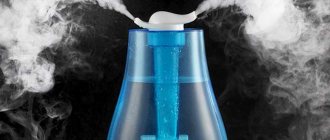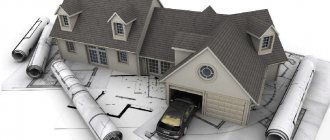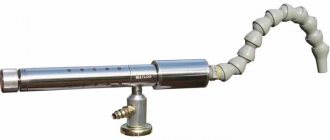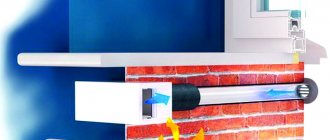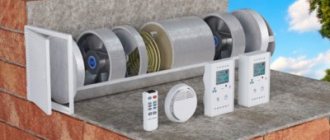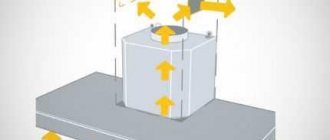What humidity should be in the nursery
The humidity in the living area depends on the climate and the season. In coastal regions and marshy areas, excessive moisture in houses will become a problem, a ventilation system will help to cope with it. During the heating season, heating devices dry the air. Frequent airing will increase the oxygen content, help get rid of excess carbon dioxide, but will cool the room.
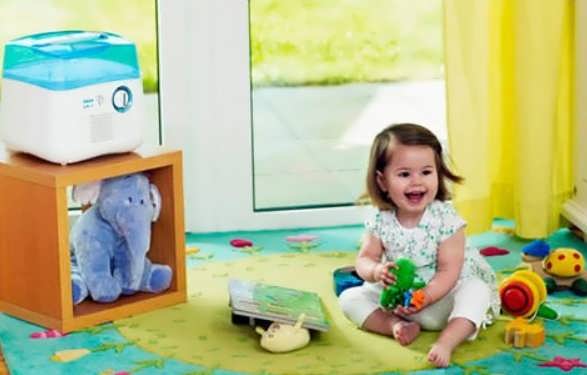
The optimal microclimate is created by a recuperation system with humidity control, but it is very costly in design and installation, its arrangement is impossible in an apartment and is not advisable in a small private house. Normal humidity values are between 40 and 60%.
Expert opinion
Nikonorov Vladimir Alekseevich
Our expert. Air conditioning and ventilation specialist with 10 years of experience.
Ask a Question
On the net you can find a lot of tips on how to increase the humidity of the air, but with their help it is impossible to control its rate. Hanging wet rags on batteries is a controversial decision from the point of view of aesthetics, and recommendations about a container with boiling water in the room are dangerous for people.
You can determine the humidity in the room based on your own observations. If you feel dryness of the skin and mucous membranes, this indicates a lack of moisture. Air oversaturation with water vapor causes a feeling of lack of oxygen.
To make the final decision on the normalization of the microclimate, it is necessary to measure the humidity of the air. Traditional methods do not give the required accuracy, so it is best to use a purchased hygrometer, and, based on its readings, purchase devices for humidifying the air.
Recommended Moisture Index
Normal room humidity is 60% on average. We usually notice excess moisture when mold appears in the corners and clothes become damp to the touch. But more often in our apartments there is not an excess of moisture, but a lack of it. The blame for everything is heating devices in winter and air conditioners in summer, because of which this figure decreases.
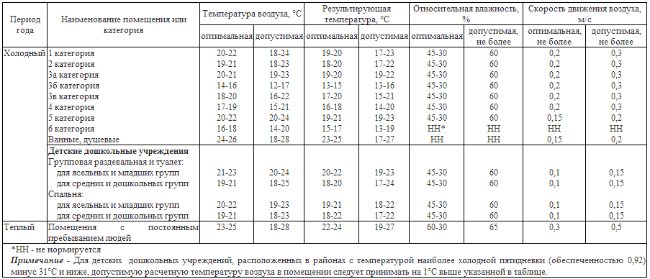

Air humidity for a newborn should be at least 50%. But this is the lowest bar. Determine the humidity with a device called a hygrometer. And most often it stops at around 20-30%, which is unacceptable for a baby. It is best if this figure reaches 70%: this is the norm for a child.
For your information: In winter, it is advisable to ventilate the children's room regularly, several times a day. It is better to use end-to-end ventilation: this way more fresh air gets into the room. In summer, in good weather and without strong temperature changes, the window can be left open all day.
Air humidifier for newborn
Temperature and humidity standards for babies are 22-25 C0 and 40-60%. When choosing a device, pay attention to the principles of its operation:
Ultrasonic
Its principles of operation are based on the supply of water to a special membrane. Ultrasonic vibrations grind the liquid, after which it mixes with air and spreads in the room. The devices are low-noise, capable of humidifying a fairly large room, but demanding on the quality of water.
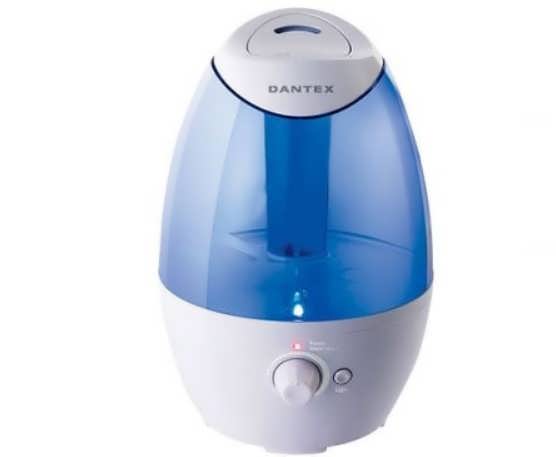

Steam
Boils and evaporates water. Suitable for installation in a cool room, because is able to increase not only humidity, but also air temperature. Has aromatherapy function, consumes a lot of electricity, not recommended for installation in places accessible to children.
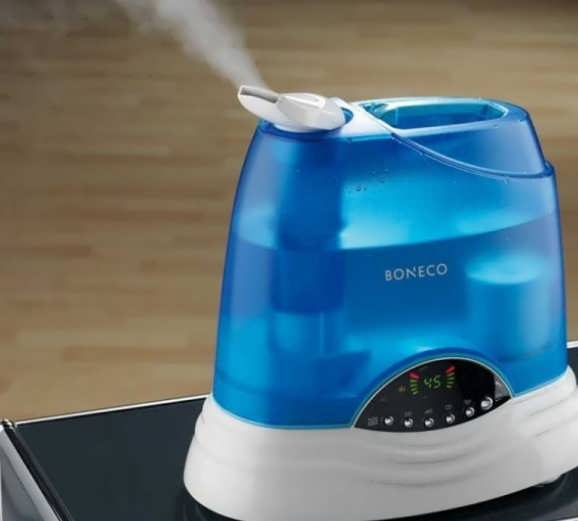

Traditional
The principle of operation of the device is based on natural evaporation of water. Built-in fans blow air to the wet cartridge. You can use tap water, the evaporation rate is regulated by the speed of the fans.
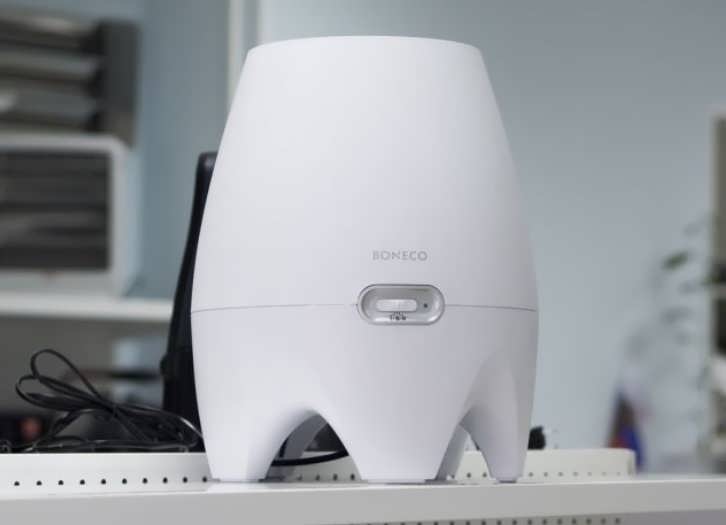

Budget models have only a humidification function, while modern and expensive devices are equipped with the following functions:
- filtration;
- ionization;
- aromatization;
- destruction of bacteria.
The most convenient devices are those with built-in humidity level sensors.
Another article about humidifiers
Creation of optimal conditions
The air exhaled by a person has an absolute humidity of 100%. This value remains constant at any humidity in the room. Therefore, the drier the inhaled air, the more fluid will be lost in the newborn. And at this age, a sudden loss of fluid can be very dangerous for the baby: his body temperature may rise and discomfort may appear. Scientists have determined the optimal value of the norm of air humidity in a newborn's room: 50-70%.
How to determine this important parameter? First of all, you can purchase a special device - a hygrometer. Very often, it is combined with electronic thermometers to measure air temperature. If it is not there, how do you know if the humidity in the room is optimal for a newborn? It's very simple - to look at the state of the crumbs, he should:
- sleep soundly without waking up ahead of time;
- have a normal skin color;
- the child's body temperature should be no higher than 37 degrees;
- the baby should not have skin irritations;
- handles and legs should not be wet, sticky;
- the baby is accompanied by calm, measured breathing.
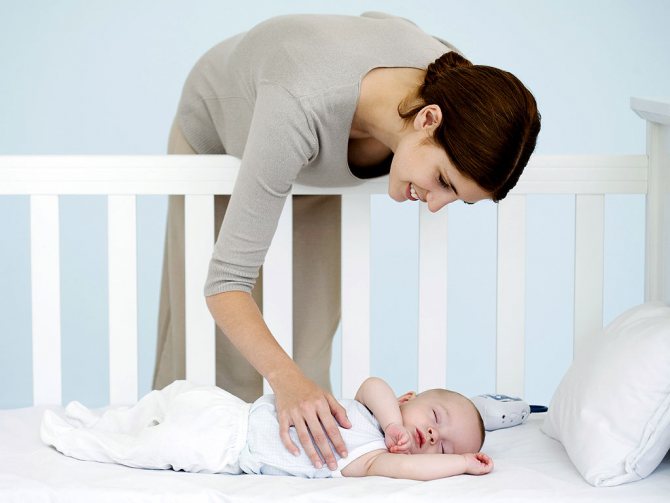

Experts note that during the beginning of the heating season, air humidity in apartments drops to a minimum level and can sometimes be equal to a third of the norm. It is imperative to fight this!
In newborns, thermoregulation mechanisms are not yet sufficiently developed. For this reason, there is a risk of overheating or hypothermia of the child's body.
According to experts, parents, based on this position, often come to the wrong conclusion, namely, they pay too much attention to protecting the child from hypothermia. For example, when preparing to meet a baby from a maternity hospital, mom and dad first of all buy an electric heater.
On a note. In the wards where newborns are kept, the air temperature is maintained at 22 degrees (usually higher). Knowing this, parents strive to ensure that the home conditions are as close as possible to the hospital. Fearing the cold, mom and dad often forget that the baby's inability to perfectly control body temperature can cause not only hypothermia, but also overheating.
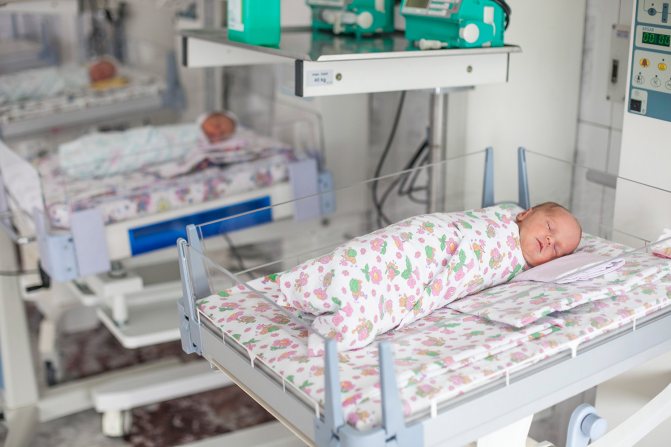

For children in the hospital, a temperature of 22 degrees is maintained
The optimum temperature in the room for a newborn varies between 18-22 degrees. According to Dr. Komarovsky, the higher this value, the worse for the newborn. Thus, hypothermia is not as dangerous for the baby as overheating.
Most doctors are of the opinion that the ideal room temperature for a newborn is 22 degrees above zero. However, there is an alternative point of view, according to which this indicator is too high, therefore, it will interfere with the baby's tempering. In this regard, pediatricians propose to reduce the temperature in the room where the child is, to 19-20 degrees.
On a note. You should not rely on your own feelings caused by the temperature regime, since in adults, the mechanisms of thermoregulation differ from those in children.
The above parameters are optimal for healthy, term infants. If the baby is premature (born prematurely), then special conditions must be created for him.In this case, the room temperature for a newborn should be 24-25 degrees.
Air humidity
The need to control this parameter is explained by the same reason - the imperfection of thermoregulation mechanisms in infants. The temperature of the air that is exhaled is 36.6 degrees, the humidity is 100%. The drier the inhaled streams, the more the body is forced to spend fluids to moisturize them, which negatively affects the health of the baby.
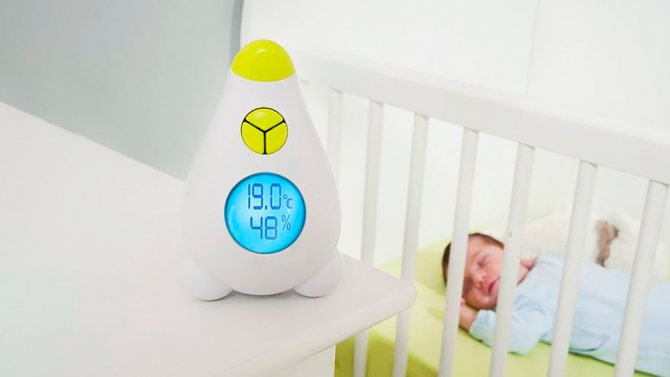

Humidity and air temperature can be measured with a special device
Most Russian families live in special climatic conditions: for half a year (all winter and partly in autumn and spring) there is a heating season. Heating systems dry out indoor air. As a result, the parameter is reduced by about 2 times. The problem is aggravated by the fact that households are concerned about the risk of freezing the child, therefore they contribute to the active heating of the child's room. The air becomes even drier, which increases the risk of health problems. These conditions can lead to problems such as:
- Weakening of the protective functions of the mucous membranes of the nose and larynx due to their drying out;
- Thickening of the blood;
- Asthma;
- Allergy;
- Skin problems and more.
That is why it is very important to maintain a comfortable temperature and humidity in the apartment for newborns in winter. The following measures contribute to maintaining normal humidity:
- Regular wet cleaning;
- Open containers with water;
- Spraying the premises with a spray gun;
- Installation of decorative fountains;
- Purchase of an aquarium;
- Using a household air humidifier (there are 2 options: steam and ultrasonic).
How to choose a humidifier for a nursery
If you live in an environmentally friendly place, your children do not suffer from allergies and respiratory diseases, and you can allocate a small amount for the purchase of a humidifier, opt for the simplest ultrasonic device that does not have additional functions.
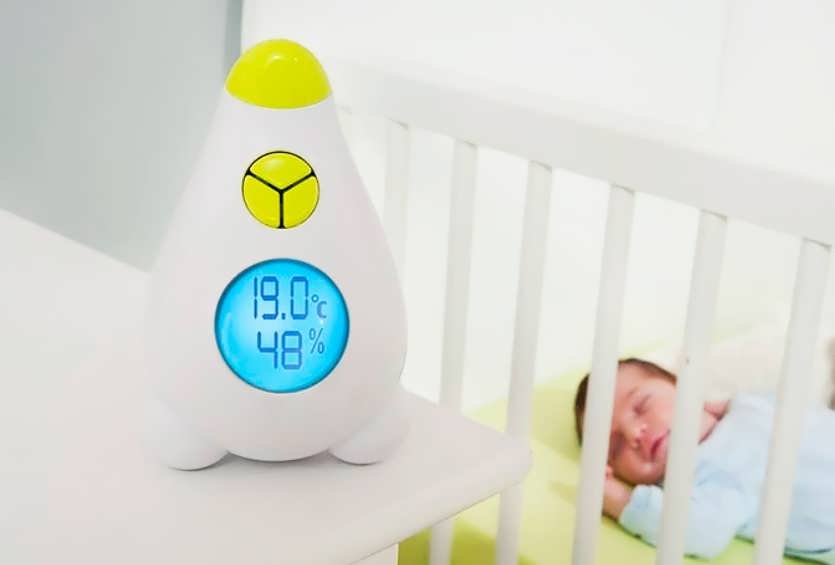

Residents of megalopolises are more prone to allergic reactions due to air pollution, the ecology of large cities is far from standards, so it makes sense to choose a device equipped with cleaning and ionization functions. It makes no sense to install a purifier-fragrance in the children's room, some odors can cause allergic reactions.
All other things being equal, give preference to a device that:
- with a compact size, it has a capacious reservoir;
- equipped with a clear control system;
- has a noise level not higher than 40 dB.
Pay attention to the estimated floor space, energy consumption and filter change frequency.
Signs of a “failure” of the humidity regime
Having shown observation, it is easy to conclude what microclimate is typical for the room.
Dry air is evidenced by the following features:
- the earth in pots with indoor flowers dries quickly, becoming covered with cracks;
- things and objects in the room are quickly electrified by static electricity;
- wet laundry dries out in a couple of hours, while it is difficult to iron;
- even with constant cleaning, the air smells of dust.
One of the first signs of dry air is the drying of the edges of the leaves of indoor flowers and their wilting.
Many factors indicate an increased proportion of water vapor in the room. In such rooms, it smells musty, and clothes and bedding are constantly damp.
The water in the flower trays is usually stagnant, and the soil in the pots is covered with a moldy white coating.
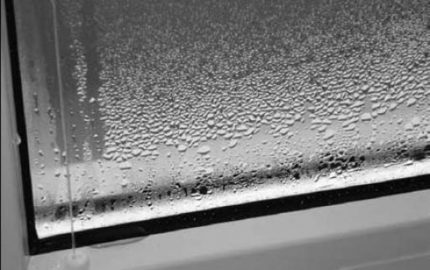

One of the first signs of increased moisture is water droplets protruding on windows, mirrors, metal
It is worth paying attention to the quickly wetting salt in an open salt shaker, swollen and poorly closing doors.
We invite you to familiarize yourself with "Attica" grapes: features of the variety and cultivation
Wallpaper moving away from the walls, mold and mildew spots that appear on horizontal and vertical surfaces can cause a lot of trouble.
Where to put a humidifier in a children's room
The main criteria for choosing a place for installing a humidifier in a nursery are safety and efficiency:
- position the device so that the child cannot reach it;
- install the humidifier at a height of at least half a meter from the floor;
- place it as close to the heater as possible to achieve optimum humidity.
Attention! The silent humidifier will not disturb sleep, which is especially important for children with increased excitability and hyperactivity.
Check the water level in the device. Modern humidifiers are equipped with a shutdown function in the absence of water, so its timely addition will ensure uninterrupted operation of the device.
Expert opinion
Nikonorov Vladimir Alekseevich
Our expert. Air conditioning and ventilation specialist with 10 years of experience.
Ask a Question
Excess moisture is just as harmful as lack of moisture, check the moisture level with a hygrometer, or use a humidifier that automatically measures this parameter.
How to use humidifiers and devices like hygrometers
The instruments used to measure humidity are called hygrometers or sensors. The equipment independently measures the indicators and displays them on the screen as a percentage. To maintain the microclimate in the bathroom, fans and hoods are used. Thanks to them, condensation does not form on the floor and walls. If there is a persistent problem with humidity in a residential room, we recommend purchasing a humidifier.
The hygrostat works in a similar way to that of a thermostat. The equipment closes and opens the contacts, the reaction takes place on the amount of water vapor in the air masses. The fan and humidifier are automated. Turning on the equipment is necessary only if there is a need.
What you need to do to anticipate the appearance of humidity in the room:
- carry out constant airing of the room;
- install exhaust systems in those rooms where dry air is observed;
- use air conditioner, fans;
- the exhaust unit in the kitchen must be powerful;
- repair work on pipes, ventilation systems and plumbing should be performed regularly;
- a climate-type system or a humidifier is the best option to get the result.
Another rule for housewives is not to hang the washed items in the living room. The hygrometer is best mounted in a draft-free room. A few recommendations for increasing indicators:
- if there are no asthmatics among the residents, you can purchase an aquarium or other decorative container with water;
- do not use the convector and other devices for heating rooms unnecessarily;
- hang a damp cloth on pipes (batteries);
- saturate the air space with moisture - use a spray bottle;
- wet cleaning is a guarantee of the health of everyone living in the house.
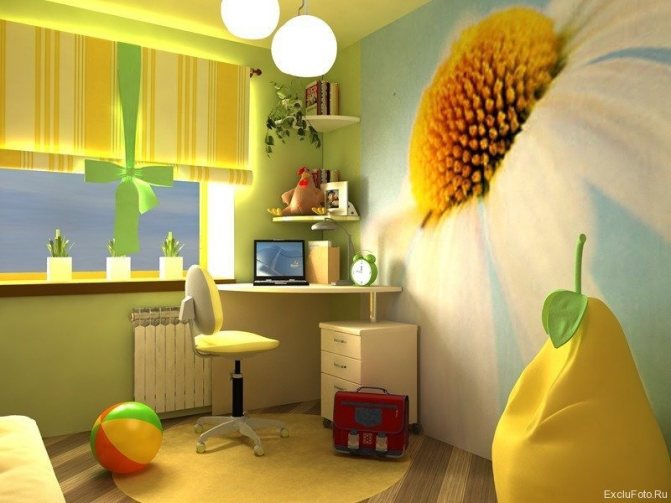

Vegetation does a good job of saving dry air. It is necessary to select professional units, depending on the needs and taking into account the microclimate of the room. Measurements must be made for a couple of days, and then devices for manipulation must be purchased. There is a certain category of equipment that is able to change the level of humidity and maintain the optimal air temperature in the room.
What is a humidifier in a nursery for?
A good humidifier is able to maintain a comfortable microclimate, clean the room from dust and bacteria.Children have weaker immunity compared to adults. During active games, the smallest particles of dust, together with bacteria, rise to the top.
Using a humidifier in your baby's room?
No Required
The drier the air, the more dust is dispersed in it. Small children and their habit of playing on the floor increase the risk of inhaling polluted air. The use of a humidifier reduces the level of dust, reduces the incidence of viral and respiratory diseases.
Excellent article 1
- Even more interesting:
What should be the normal parameter?
If we talk about well-being, scientists are unambiguous: people feel best at a relative humidity in the range of 30-60%.
But from the point of view of health, the boundaries are somewhat narrowing.
The conditions of a good climate in the house are important for human life. It is on the appropriate level of moisture that a comfortable stay in a particular room depends entirely. Each living area has its own parameters of the desired temperature and humidity, depending on the purpose. The main points for many are to ventilate the room and measure the temperature of the surrounding air, the state of living organisms living there.
The average data established by specialists is 45%. It can fluctuate depending on the purpose, size and type of room. Operating conditions are an important factor. Of course, small errors are possible both in winter and in summer. If the humidity is too high or too low, there is some discomfort.
- dining room - up to 50%;
- bedroom - up to 50%;
- children's room - up to 60%;
- kitchen and bathroom - 40 - 60%;
- library, study - up to 40%.
Of course, the bathroom and kitchen will be higher in terms of performance, because the norm for them is higher.
In winter, the heating season begins in the house, which significantly dries the air inside the apartment. People living inside may feel discomfort in the dry mucous membrane of the nose and throat. Hair becomes overdry, becomes brittle, skin peels off. If the humidification level in the room is not correct, an unpleasant phenomenon such as static electricity appears. This process becomes the basis for the spread of mites and microbes. The main problems that can arise with excessive dry air:
- diseases and unpleasant consequences for the skin - dermatitis, cracks, wrinkles, peeling skin, problems with the mucous membrane. The skin becomes dry, loses its elasticity, hair and nail plate breaks;
- eye problems - itching, dry eyeball, redness. As a result, conjunctivitis, a feeling of a speck in the eye, may occur;
- the heart valve wears out faster. A person often and quickly gets tired, there are complaints of headaches, activity and efficiency decrease. The heart is exposed to severe stress, the blood becomes thicker;
- metabolism and general work of the gastrointestinal tract worsens - the viscosity index of gastric and intestinal juice becomes higher;
- dryness occurs inside the respiratory tract, local immunity becomes weaker, a person often catches a cold, gets sick;
- the air quality becomes much lower - allergens accumulate in the air masses, which in normal conditions are bound to normal humidity by water particles.
Insufficient moisture affects plants, animals, furniture and household utensils made of wood, sometimes it is necessary to carry out finishing work again - the coatings become faded, cracks.
A high percentage of room humidity can provoke problems such as:
- diseases of the respiratory tract become frequent guests - rhinitis, forms of bronchitis, pneumonia, allergic reactions, the condition of asthmatics worsens - the disease turns into a chronic form that is practically not treated;
- the condition in the room worsens, stuffiness appears, dampness and an uncomfortable feeling arises;
- there is no feeling of freshness - pathogenic microbes multiply, which cause unpleasant odors;
- the laundry dries out much longer and remains damp.
The humidity increased by several percent provokes the active development of harmful microorganisms: fungal, pathogenic, mold. The environment around a person reacts sensitively to an increase in humidity - the plants rot, disappear. Mold appears on ceilings, walls, decoration, wood surfaces are deformed, and paper products, such as books, change their structure.
The physiology of a child is much softer than that of an adult. Children are more likely to suffer from illnesses, respiratory colds, may freeze or overheat. The temperature regime and humidity indicators must necessarily be appropriate for the child's room, it is necessary to create special conditions to protect the small organism from stress factors.
Overdried air in the children's room is enemy number 1. The air masses in the room must be humidified, because diseases of the mucous membranes in the baby can occur, a problem with immunity appears. A common symptom is peeling and itching of the skin. The percentage of moisture in the microclimate of the children's recreation area should not exceed 50 - 60%. If the child has a cold, the moisture level must be increased - so it is better for mucous membranes to cope with drying out.
The ratio of humidity in winter and in summer in the room for the crumbs should be the same, but with one exception - the air temperature should be at least 24 degrees. If the indicators are higher, the nursery will turn into the tropics.
Sanitary norms and requirements for premises
After numerous studies, checks and confirmation of the test results, which were carried out by a group of narrowly specialized specialists (doctors, teachers, epidemiologists, scientists), the optimal indicators of temperature and humidity were derived.
And the state has enshrined the obligation to comply with them in kindergartens and schools at the legislative level - SanPiN.


By maintaining the balance of food, physical and mental stress, as well as maintaining an optimal indoor climate, you can achieve incredible results. The child becomes active, grows well, develops
In addition, maintaining the recommended regime indoors helps to strengthen the immune system, children are much less likely to get sick. And in case of illness, the immune system copes with viruses without any problems - diseases are less complicated.
In the first years of their lives, it is important for children that the SanPiN standards for humidity and temperature are observed in the premises of the kindergarten. This is especially true when the seasons change, when heating and air conditioning systems are actively used.
Since children are engaged in a variety of activities throughout the day, each room has its own temperature regime.
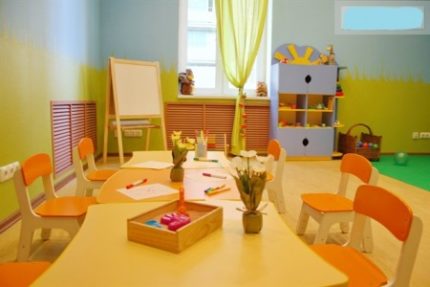

The child spends in kindergarten from 8 to 10 hours a day for 5-6 days a week. He eats, sleeps, plays, studies there. Therefore, it is so important that the microclimate in the premises of the garden corresponds to the age characteristics of the body of preschoolers.
In accordance with SanPiN, the air temperature in the garden should be:
- 22-24 ° С - nursery groups;
- 21-23 ° С - junior and senior groups;
- 19-20 ° С - bedrooms;
- 22-24 ° С - toilet in a manger;
- 19-20 ° С - toilets of older groups;
- 22-24 ° С - medical cabinet;
- 19-20 ° С - halls for active classes;
- more than 12 ° С - walking veranda;
- from 29 ° С - pool;
- 25-26 ° С - changing rooms and showers;
- from 15 ° С - heated interbody passages.
This temperature difference is explained by the fact that for each type of activity of children in the institution, a specially designed room / hall is equipped for this. The child sleeps in the bedroom and under the covers - he should not be cold / hot.
Physical education classes are held in the gym, where the temperature is slightly lower than in the playroom, since the classes are active and children should not sweat in the process. The temperature in the game is slightly higher than in the gym. there are also quiet activities and games.
For all premises of the nursery, the standards provide for a temperature higher than for older children.
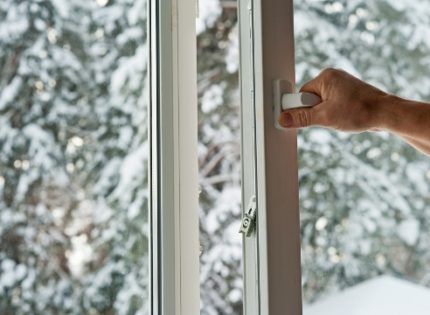

To ensure the required level in the gardens, regular through and corner ventilation must be carried out for 10 minutes and at least once every 1.5 hours.
These recommendations are regulated by the gardeners depending on the weather conditions. Children should not be in a room that is ventilated.
Humidity in kindergarten should be in the 40-60% range. This value is regulated by ventilation:
- a short-term decrease in room temperature by 2-4 ° C is considered normal;
- cannot be ventilated through the toilet;
- bedrooms are ventilated until naps;
- in winter, the vents close tightly half an hour before the children wake up.
Failure to comply with these standards can adversely affect the well-being and activity of children. As a rule, frequent colds in a group can be caused by a negligent attitude to the SanPiN prescriptions of preschool workers.
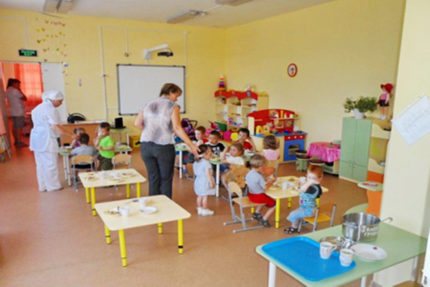

The inflow of fresh air in the kindergarten groups contributes to the saturation of cells and cerebral cortex with oxygen and, as a result, improves the general condition of the child's body. Children are cheerful, play actively, attentive in the classroom
Violation of the temperature regime and not maintaining the necessary humidity provokes the appearance of such diseases in preschoolers:
- ARVI;
- growth of adenoids;
- persistent allergies and asthma;
- dermatitis.
If children in a group are often sick or there are reasonable suspicions of non-compliance with standards, parents can initiate an inspection of the garden, as well as contact the district education department or even the prosecutor's office.
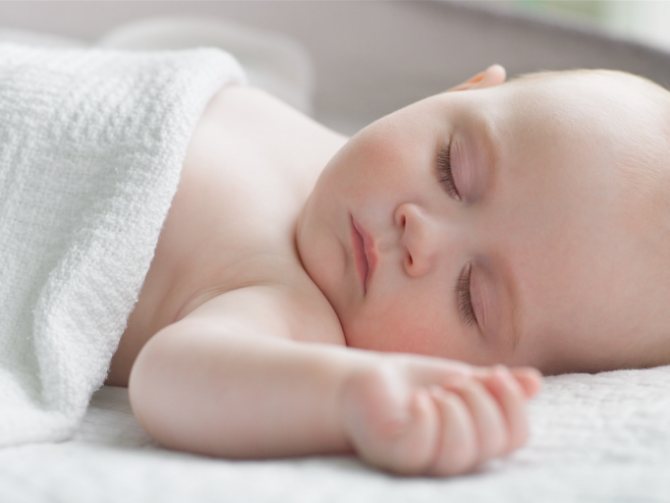

The requirements of SanPiN 2.4.2.2821-10 are no less strict with regard to the organization by a school institution of an optimal microclimate for students.
And while they are not geared towards ranking temperature and humidity readings by age / grade, they do take into account the following factors:
- The upper and lower temperature thresholds for classrooms and auditoriums are 18-24 ° C.
- The temperature regime in the halls intended for conducting classes related to vigorous physical activity is 17-20 ° С.
- The minimum temperature in the pool and showers is from 25 ° C.
In a school institution, it is especially important to adhere to the standards of SNIP indicators for the balance of heat and humidity. Indeed, within the framework of one building, a large number of children gather every day, who actively consume oxygen, so there is no way to do without regular ventilation.
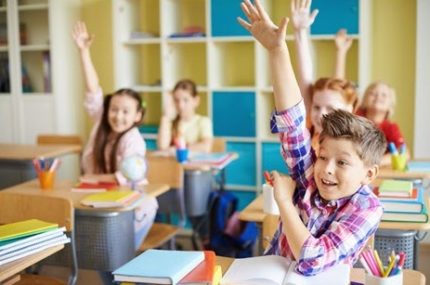

Children spend some of their time in one position, which slows down blood flow and metabolism. To keep them from freezing, it is important that the school is not cold. And since children are simply not adapted to move slowly, it should not be hot in the rooms.
Maintaining the optimum temperature throughout the day of classes creates favorable conditions for the educational activities of children. They are not hot in physical education class and they are not cold for 45 minutes of the lesson in a seated position. Such temperatures can be safely called comfortable for a child.
Normally, the optimal air humidity in the school is the same as in the kindergarten.
To maintain it in the required parameters, regular airings are carried out:
- all classrooms - before and after training sessions;
- classrooms - during breaks;
- school corridors - while schoolchildren are in class.
The duration of each ventilation is regulated depending on the season and the air temperature outside. Short-term temperature drop should not exceed 2-4 ° С.
Sometimes in classrooms the windows are closed during the lesson and a large number of children - 12-30 schoolchildren find themselves in a closed air space. This is fraught with disability for them, decreased mental activity.
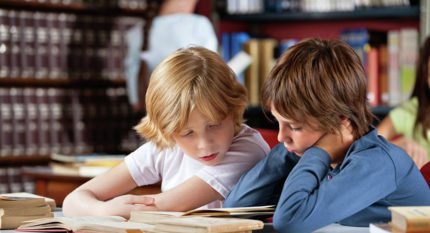

Despite the fact that the educational load for children is calculated taking into account the age characteristics of their body and psyche, it is not easy for them to cope with classes. It is especially difficult to concentrate on the lesson and perceive information with the arrival of the heating season, when the contrast of temperatures in the room and outside is great. Too hot and stuffy in the classroom - children become lethargic, apathetic, and at low temperatures they are simply cold and not up to school
Therefore, even short-term ventilation during breaks is important, because the air in the classroom is enriched with oxygen. Especially in old school buildings with problematic ventilation.
Local authorities of Rospotrebnadzor carry out supervisory functions for maintaining the temperature and humidity regime in schools. Employees of this organization conduct scheduled and extraordinary inspections (in case of suspicion of violations, complaints) of children's institutions.
For example, if the temperature at school is not observed, the child may faint and be seriously injured or acquire a disease such as asthma for life. Therefore, even the suspicion that the employees of the children's institution are violating the regime may be a sufficient reason for an unscheduled check.
If violations are detected, the following decisions may be made, binding for execution:
- An order to eliminate technical violations that negatively affect the temperature and humidity in the premises. These can be breakdowns of pipes of water supply systems, heating, etc.
- For negligence, workers can be punished in an amount equivalent to 100-300 minimum wages.
- According to the act of checking and identifying violations that caused moderate or severe harm to the health of the child, a criminal case can be initiated, which is fraught with imprisonment for up to 5 years.
Parents, privately or together, can write an appropriate letter to Rospotrebnadzor or leave a statement / complaint / claim on the official website of the organization. You can also contact the supra-departmental authorities on the website of the State Services - the Ministry of Education, the regional office of the Ombudsman for the Rights of the Child, or the prosecutor's office.


Rospotrebnadzor vigilantly monitors compliance with its instructions, because their violation can not only negatively affect the health of children and employees of institutions, but cause significant harm to health
Do not be afraid to disturb someone's peace or some kind of persecution against a child from the administration of a kindergarten or school. These problems are much easier to cope with than acquired asthma or chronic ENT diseases.
One of the reasons for the frequent morbidity in children of all ages is non-observance of the temperature regime and critical indicators of humidity in the apartment. Most often, this is caused by the parents' ignorance of what norms to adhere to and how to check them.
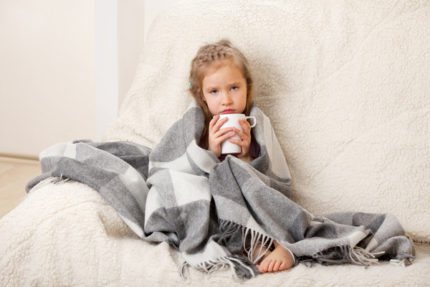

From dry air, the mucous membrane of the child begins to dry out, it becomes difficult for him to breathe. In addition, trying to dress their beloved child warmer, the parents themselves, without knowing it, expose him to additional risk - it can be blown out even with the slightest draft
Sometimes parents are simply afraid to harm their child, leaving everything as it is and sincerely wondering why the child is apathetic, eats badly or is constantly ill.
To ensure a comfortable temperature and optimal air humidity in an apartment for a child, you can focus on the standards prescribed by SNIPs.
If flowers dry up in the house, especially during the heating season, this indicates a low level of humidity in the apartment. It is urgent to take action and raise it to at least 50%, while the norm for a child is 40-60%.
In common rooms, a comfortable temperature for a person is felt at a temperature of 21-24 ° C, in a sleeping room, a lower indicator can be maintained - 19-21 ° C. Then the sleep will be stronger and the child will breathe easier.
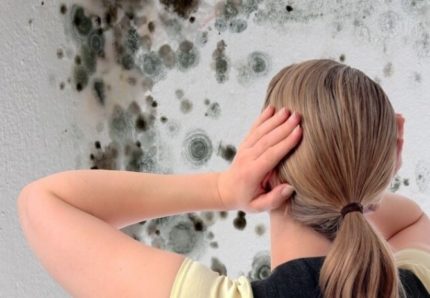

High humidity in bathrooms together with poorly functioning ventilation can cause the appearance of fungus, mold, whose spores will then be inhaled by the whole family.
Room temperature and humidity should be balanced. Since if both indicators are high, then the microclimate in the apartment will resemble a tropical one, which is also not useful for either adults or children.

